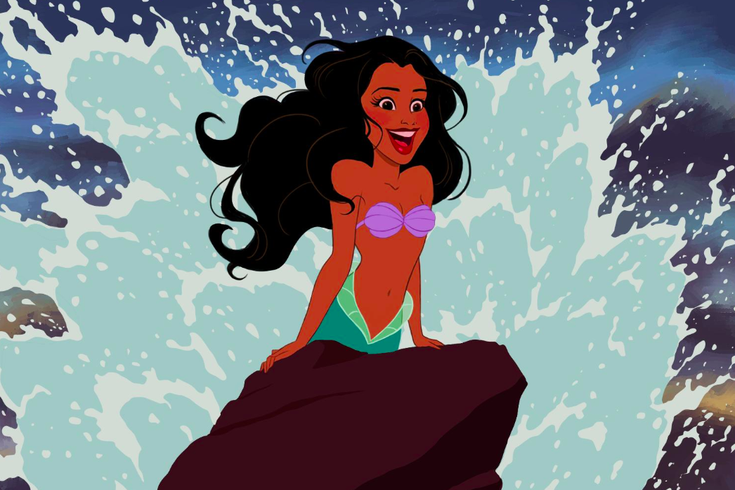Insights
Under the Sea, There’s Diversity.

Earlier this month, Disney announced that actress Halle Bailey would play Ariel in the new live-action version of The Little Mermaid. The decision received backlash from some fans who felt protective of the original Disney animated film, a reaction that has become somewhat expected in an age where classic stories are being remade more frequently, often with representation in mind.
When I mentioned the news to my mom, it prompted her to share a story with me that I had never heard.
I was six years old. It was a couple weeks before Halloween, so my mom took me to a costume shop. According to her, I was obsessed with Ariel. The movie was constantly playing on my family’s TV, and white printer paper around my house was covered in messy sketches of the Little Mermaid. I listened to “Part of Your World” as I fell asleep each night.
As my mom and I sorted through an array of costumes in Party City, she came across the perfect one: an Ariel costume with a turquoise tail, a beaded purple top, and a bright red wig. My mom ushered me into a dressing room to try on the colorful ensemble. I wiggled into the tail and waited in anticipation for my mom to help me put on the bright red wig. I turned around to see myself in the mirror for the first time as my favorite princess.
I stared at myself for a long time, taking it all in. Then I said, “It doesn’t look right. My skin is too dark.”
That year, I opted to be Pocahontas instead.
The news of a black woman portraying what was originally an animated white character has sparked a variety of responses. Some have argued that not having an actress who resembles “an ethnic European” is “cultural appropriation,” and others have gone so far to say that it would be impossible for a mermaid to be black because the lack of sun exposure under the sea would prohibit melanin production. The hashtag #NotMyAriel started trending on Twitter the day after the announcement’s release.
And while the clapbacks against these arguments came quickly, the initial outcry made it impossible to ignore the sentiment which fuels these kinds of responses. In isolation, these complaints seem merely absurd, but taken together, they represent something more serious: an insidious racism that masquerades as a dedication to “tradition.”
Perhaps the most popular argument among critics of Disney’s casting decision is that it creates a double standard; if it’s inappropriate to cast a white woman as a non-white princess, shouldn’t it be inappropriate to cast a black woman as Ariel?
Ultimately, these complaints fail to take context into account. There is a time and place when race must be taken into consideration for casting. That time and place is when culture and ethnicity are essential parts of the story itself.
For example, in casting Liu Yifei as Mulan in the upcoming live-action remake, culture and ethnicity were reasonable considerations because they are integral to the story itself. Mulan’s story centers on Chinese traditions of filial piety and societal expectations, traditions which force her to choose between the gender norms of her culture and her desire to serve in the Chinese military. At its core, her story is intrinsically cultural, making the actress’s race relevant. It’s imperative, in this situation, that a Chinese actress plays a Chinese character.
The casting of The Little Mermaid is different.
To be clear, the story does originate from Danish writer Hans Christian Andersen, who was white and wrote for a predominantly white, European audience. But the story doesn’t center on Danish culture or traditions. Her story is one of teenage rebellion, serving as a universal ode to those who are willing to give up everything they have to explore the unknown. This story — of longing for a different life — can be anyone’s story, independent of race or culture.
Also, if we can be frank — it’s ultimately a story about mythological creatures, so pretty much any argument about what things should look like falls flat.
So if the story can be anyone’s, then we should let it be. Otherwise, we risk subjecting audiences to symbolic annihilation: the idea that if you don’t see people like you in the media you consume, you must somehow be unimportant.
And that’s the point — representation benefits everyone, and we need more of it. We need to be telling stories that recognize more than just one group. Equitable representation is important whenever we try to communicate or message anything effectively. When we throw away the chance to show diversity in race and in stories, we ourselves become less effective storytellers and limit the reach we can have.
This principle goes beyond entertainment and film. It extends to who is on the front covers of our magazines, who is reporting our news, and who is running our companies.
There are a lot of positive shifts toward diversity that are already happening. In May, Megan Rapinoe became the first openly gay woman to pose for a Sports Illustrated swimsuit issue. In 2018, Laverne Cox became the first openly trans woman to appear on the front cover of Cosmopolitan. In 2017, Geisha Williams became the first Latina CEO of a Fortune 500 company. All, at one point, faced backlash. But as we continue to demand and expect diversity in all places where communication is critical, we normalize equitable representation and allow the widest possible range of stories to be told.
So let’s celebrate this news and the fact that Disney is doing exactly what it should be doing — shining a spotlight on those who have historically been excluded and made to feel unimportant. Decisions like these remind people that anyone has the potential to be a player on the world stage.
Because every little girl deserves to leave Party City knowing that she looks “right” in an Ariel costume.